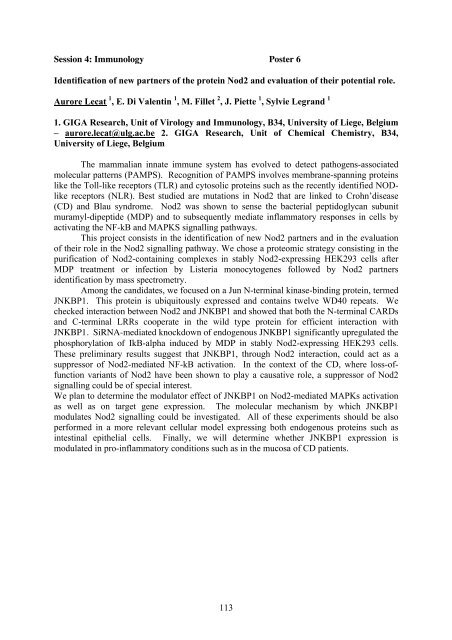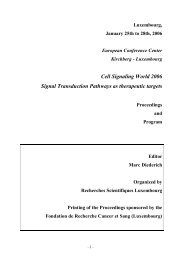Abstract book (download .pdf file) - Redox and Inflammation ...
Abstract book (download .pdf file) - Redox and Inflammation ...
Abstract book (download .pdf file) - Redox and Inflammation ...
Create successful ePaper yourself
Turn your PDF publications into a flip-book with our unique Google optimized e-Paper software.
Session 4: Immunology Poster 6<br />
Identification of new partners of the protein Nod2 <strong>and</strong> evaluation of their potential role.<br />
Aurore Lecat 1 , E. Di Valentin 1 , M. Fillet 2 , J. Piette 1 , Sylvie Legr<strong>and</strong> 1<br />
1. GIGA Research, Unit of Virology <strong>and</strong> Immunology, B34, University of Liege, Belgium<br />
– aurore.lecat@ulg.ac.be 2. GIGA Research, Unit of Chemical Chemistry, B34,<br />
University of Liege, Belgium<br />
The mammalian innate immune system has evolved to detect pathogens-associated<br />
molecular patterns (PAMPS). Recognition of PAMPS involves membrane-spanning proteins<br />
like the Toll-like receptors (TLR) <strong>and</strong> cytosolic proteins such as the recently identified NODlike<br />
receptors (NLR). Best studied are mutations in Nod2 that are linked to Crohn’disease<br />
(CD) <strong>and</strong> Blau syndrome. Nod2 was shown to sense the bacterial peptidoglycan subunit<br />
muramyl-dipeptide (MDP) <strong>and</strong> to subsequently mediate inflammatory responses in cells by<br />
activating the NF-kB <strong>and</strong> MAPKS signalling pathways.<br />
This project consists in the identification of new Nod2 partners <strong>and</strong> in the evaluation<br />
of their role in the Nod2 signalling pathway. We chose a proteomic strategy consisting in the<br />
purification of Nod2-containing complexes in stably Nod2-expressing HEK293 cells after<br />
MDP treatment or infection by Listeria monocytogenes followed by Nod2 partners<br />
identification by mass spectrometry.<br />
Among the c<strong>and</strong>idates, we focused on a Jun N-terminal kinase-binding protein, termed<br />
JNKBP1. This protein is ubiquitously expressed <strong>and</strong> contains twelve WD40 repeats. We<br />
checked interaction between Nod2 <strong>and</strong> JNKBP1 <strong>and</strong> showed that both the N-terminal CARDs<br />
<strong>and</strong> C-terminal LRRs cooperate in the wild type protein for efficient interaction with<br />
JNKBP1. SiRNA-mediated knockdown of endogenous JNKBP1 significantly upregulated the<br />
phosphorylation of IkB-alpha induced by MDP in stably Nod2-expressing HEK293 cells.<br />
These preliminary results suggest that JNKBP1, through Nod2 interaction, could act as a<br />
suppressor of Nod2-mediated NF-kB activation. In the context of the CD, where loss-offunction<br />
variants of Nod2 have been shown to play a causative role, a suppressor of Nod2<br />
signalling could be of special interest.<br />
We plan to determine the modulator effect of JNKBP1 on Nod2-mediated MAPKs activation<br />
as well as on target gene expression. The molecular mechanism by which JNKBP1<br />
modulates Nod2 signalling could be investigated. All of these experiments should be also<br />
performed in a more relevant cellular model expressing both endogenous proteins such as<br />
intestinal epithelial cells. Finally, we will determine whether JNKBP1 expression is<br />
modulated in pro-inflammatory conditions such as in the mucosa of CD patients.<br />
113




